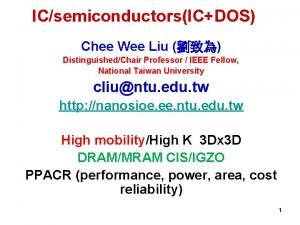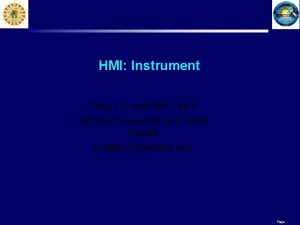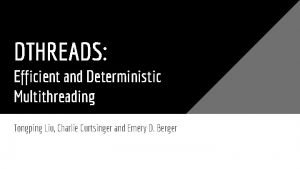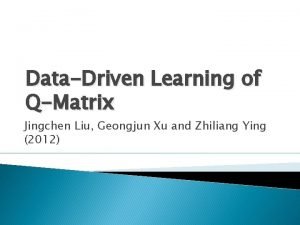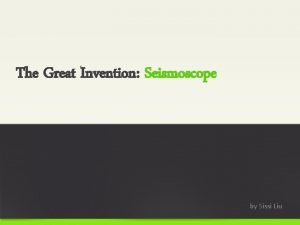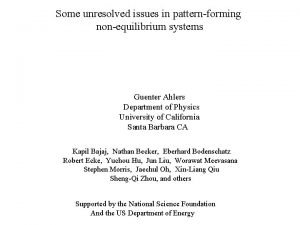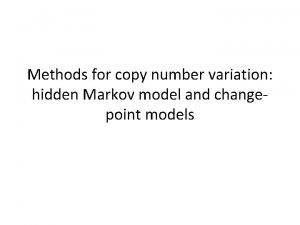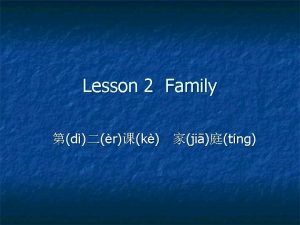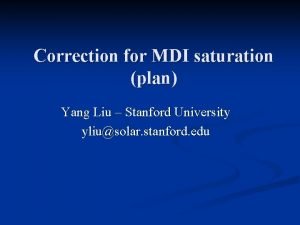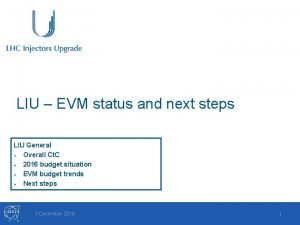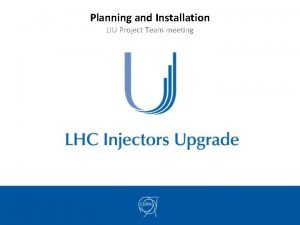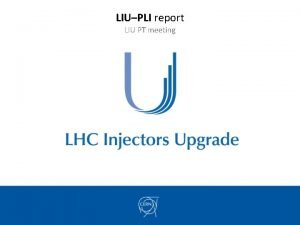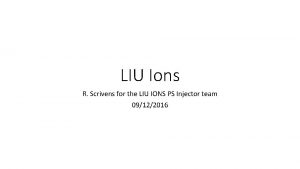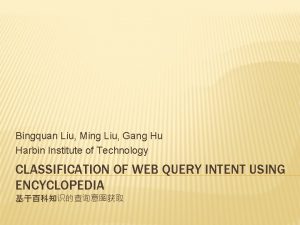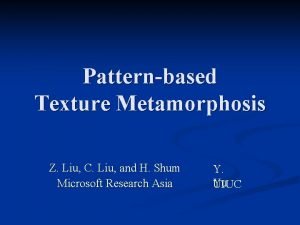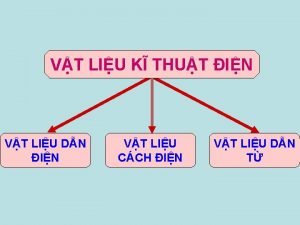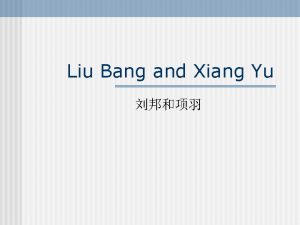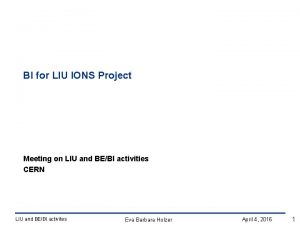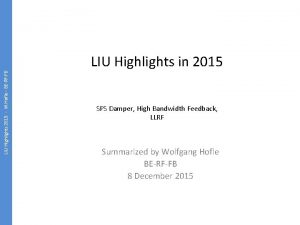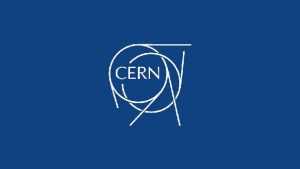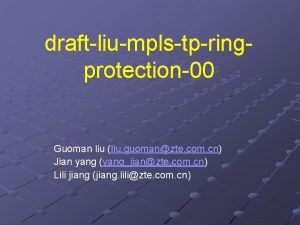Summary of Session 5 LIU Summary session of






















- Slides: 22


Summary of Session 5: LIU Summary session of the LHC Performance Workshop - Chamonix 2014 http: //indico. cern. ch/event/341704/ CERN, 8 October, 2014 M. Meddahi, G. Rumolo LIU Project Team: J. Coupard, H. Damerau, A. Funken, S. Gilardoni, B. Goddard, K. Hanke, B. Holzer, Lombardi, D. Manglunki, B. Mikulec, E. Shaposhnikova, M. Vretenar Based on the input from the speakers: T. Argyropoulos, H. Bartosik, M. Bodendorfer, V. Kain, A. Lombardi and subsequent discussions … A.

Outline • Introduction: – Goals and means of the LIU project – Timelines of LIU • Baseline LIU improvements and their impact on performance of LHC injector synchrotrons – – – Ion chain Linac 4 PSB PS SPS • Can we do it better? – Higher intensity – High brightness challenges • Conclusions

Goals and means of the LIU project Increase intensity/brightness in the injectors to match HL-LHC requirements Þ Enable Linac 4/PSB/PS/SPS to accelerate and manipulate higher intensity beams (efficient production, space charge & electron cloud mitigation, impedance reduction, feedbacks, etc. ) Þ Upgrade the injectors of the ion chain (Linac 3, LEIR, PS, SPS) to produce beam parameters at the LHC injection that can meet the luminosity goal Increase injectors’ reliability and lifetime to cover HL-LHC run (until ~2035!) closely related to CONSolidation Þ Upgrade/replace ageing equipment (power supplies, magnets, RF…) Þ Improve radioprotection measures (shielding, ventilation…)

Timelines of the LIU project • LIU (machine and simulation) studies during Run 2 until LS 2 – Key dates for pending decisions until 2016 • LIU installations and hardware works mainly during LS 2 • Beam commissioning of LIU beams – Pb ion beams need to be ready by 2020 ion run – Proton beams during Run 3 to be ready after LS 3 2 Protons (E)YETS Ions Long Shutdown

LIU-IONS target: 7 x nominal peak luminosity! Lpeak Beam energy Achieved in 2011 5 x 1026 Hz/cm 2 3. 5 Z Te. V LIU-IONS 7 x 1027 Hz/cm 2 7 Z Te. V IBS & space-charge already at the limit on SPS flat bottom … We need to pack a larger number of bunches in LHC, of about the same 2013 intensity Talk by M. Bodendorfer

Means to achieve target luminosity • Source & Linac 3: – Increase beam current by improving Low Energy Beam Transport (LEBT) • Identify and remove bottlenecks (simulation & diagnostics needed) – Injection rate: 5 Hz 10 Hz • LEIR: – Increase number of injections – Understand mitigate large beam losses at RF capture • More advanced modeling and MDs needed • PS: – Bunch splitting to produce 4 bunches with 100 ns bunch spacing • SPS: – Mitigate beam degradation at flat bottom • Reduction of RF noise, Q 20 optics – Upgrade SPS injection system with 100 ns rise time – Longitudinal slip-stacking 50 ns bunch spacing Talk by M. Bodendorfer

Means to achieve the target luminosity • Source & Linac 3: – Increase beam current by improving Low Energy Beam Transport (LEBT) • Identify and remove bottlenecks (simulation & diagnostics needed) – Injection rate: 5 Hz 10 Hz • LEIR: – Increase number of injections – Understand mitigate large beam losses at RF capture • More advanced modeling and MDs needed • PS: – Bunch splitting to produce 4 bunches with 100 ns bunch spacing • SPS: – 35% loss at max. extracted intensity needs to be Mitigate beam degradation at flat bottomunderstood and reduced • Reduction of RF noise, Q 20 optics – Upgrade SPS injection system with 100 ns rise time – Longitudinal slip-stacking 50 ns bunch spacing Talk by M. Bodendorfer

LIU proton target HL-LHC beam parameters 25 ns Achieved in 2012 N (x 1011 p/b) HL-LHC 2. 3 1. 2 e (mm) 2. 6 (std) 1. 4 (BCMS) Bl (ns) 2. 1 1. 7 1. 5 Injectors must produce 25 ns proton beams with about double intensity and higher brightness A cascade of improvements is needed across the whole injector chain to reach this target

Linac 2 Linac 4 • Linac 4 will replace Linac 2 – H- injection into PSB at 160 Me. V – Expected double brightness for LHC beams out of the PSB Present performance y = 0. 0059 x Expected performance with Linac 4 Talk by G. Rumolo

Linac 2 Linac 4 • Linac 4 is being commissioned stage by stage with a temporary source – Acceleration to 12 Me. V is validated • RFQ and chopper behave correctly • DTL tank 1 accelerates the beam without losses – Emittance measurements agree with code predictions (PARMTEQ, PATH, TRACEWIN) • Reconstruction methods for transverse and longitudinal emittances are also validated! Simulations Slit-and-grid measurements Talk by A. Lombardi

Linac 2 Linac 4 • New caesiated source ready for use – Will provide 40 m. A within 0. 35 mm • > 20 turns injection for future LHC beams simulations ongoing to establish future emittance vs. intensity curve • ~100 turns for future ISOLDE beams attainable maximum injected intensity to be assessed – Need to resort to magnetron and R&D to achieve the originally specified 80 m. A • Strongly space charge dominated beam transport • Quite high cost • Half-sector test planned for June 2016 to “simulate” injection into PSB with the real equipment Talk by A. Lombardi

Main means to achieve the target HL-LHC proton beam parameters • PSB: – Double brightness with injection from Linac 4 – Acceleration to 2 Ge. V with new (or upgraded) C 02+C 04 RF systems and new main power supply • PS: – Injection at 2 Ge. V – Beam production schemes – Feedback systems: • Newly installed wide-band longitudinal feedback against CBI • Transverse feedback against headtail and e-cloud instabilities • SPS: – Power upgrade of the main 200 MHz RF system (plus double available 800 MHz voltage) – Electron cloud mitigation through a-C coating (baseline) or beam induced scrubbing, possibly with doublets (decision mid-2015)

Standard scheme (72 b trains) after LIU • With Linac 4 + LIU upgrades HL-LHC after connection of Linac 4 – SPS 200 MHz upgrade – SPS e-cloud mitigation – PSB-PS transfer at 2 Ge. V • Limitations standard scheme – SPS: longitudinal instabilities + beam loading – PSB: brightness • Performance reach – 2. 0 x 1011 p/b in 1. 9μm (@ 450 Ge. V) – 1. 9 x 1011 p/b in 2. 3μm (in collision) Talk by G. Rumolo

Can we do it better for HL-LHC? • Higher bunch current from the SPS (larger longitudinal emittance at flat top) –. . . Intermediate opticshelp (Q 22)and trade off between margin in TMCI can LHC also accept longer bunches threshold and constraint on RF power from the SPS with 200 MHz RF system? – Reduced ramp rate & bunch rotation at 450 Ge. V – Impedance identification and reduction • Higher number of bunches into LHC – Inject trains of 80 bunches into the SPS • Based on injecting 7 bunches from the PSB into PS • One out of 21 bunches is kicked out with transverse damper before acceleration • Higher brightness from injectors – BCMS beams • Trains of 48 bunches into SPS • High damage potential for beam intercepting devices in the SPS, transfer lines and LHC Talks by T. Argyropoulos, H. Bartosik, V. Kain

80 bunches from PS Remove 1 bunch with transverse feedback: 21 20 bunches Use of TFB to kick out single circulating bunch validated in MD ! 2 double splittings triple splitting 7 => 21 bunches 20 => 40 => 80 bunches instead of 72 PS extr. kicker rise time 89 ns (1 -99%) => O. K. 26 Ge. V 4 bunches +3 (instead of 2) bunches Inj. kicker rise time O. K. 1. 4 Ge. V h=7 Talk by H. Bartosik Up to 5% more bunches in LHC 2. 5 Ge. V h=21 h=42 h=84

SPS impedance identification and reduction Ø Vacuum flanges (≈550) are the likeliest candidate • Particle tracking simulations show that impedance of vacuum flanges reduces intensity threshold for longitudinal instabilities by a factor 2 Talk by T. Argyropoulos

SPS impedance identification and reduction Ø Vacuum flanges (≈550) are the likeliest candidate • Particle tracking simulations show that impedance of vacuum flanges reduces intensity threshold for longitudinal instabilities by a factor 2 Ø Preliminary suggestions to reduce the impedance of the SPS vacuum flanges (both requiring 15 – 30 weeks of work) q Partial shielding + damping § Limited gain and applicable only to half of the flanges q Flange redesign § Very effective and applicable to all flanges § Higher cost Ø Major extra activity to be possibly added to baseline, decision needed in 2015 to be able to prepare for LS 2 Talk by T. Argyropoulos

BCMS scheme (48 b trains) with LIU • With Linac 4 High brightness comes with: • LIU upgrades q Larger IBS rates – SPS 200 MHz upgrade q Challenge HL-LHC for emittance measurement – SPS e-cloud mitigation – PSB-PS transfer at 2 Ge. V devices q Fewer bunches in LHC (~5%) • Limitations BCMS scheme q Octupoles less effective to stabilize – SPS: beam longitudinal instabilities + beam loading – PS: space charge protection – devices SPS: space in charge ð High damage risk of SPS, transfer lines and LHC • Performance reach – 2. 0 x 1011 p/b in 1. 37μm (@ 450 Ge. V) – 1. 9 x 1011 p/b in 1. 65μm (in collision) Talks by G. Rumolo, V. Kain

Dangers of high brightness Energy deposition depends on total intensity as well as spot size • Choice of material is for protection devices challenging – Estimated stresses from impact of high brightness beams beyond strength of materials used in passive protection absorbers – R&D needed to find suitable materials for new absorbers post LS 2. • Hi. Rad. Mat facility will use SPS beam at 450 Ge. V to test – Material properties (used as input for simulations) – Robustness against “simulated” future beams – New promising materials (e. g. 3 D Carbon-Carbon) Talk by V. Kain

Conclusions • Protons: – LIU baseline program established to ensure production of LHC proton beams with parameters close to HL-LHC request • Right brightness, ~15% lower intensity per bunch • Very dense machine and simulation study program to – Further improve our parameter estimates – Take decisions latest 2015 for few remaining pending items – Promising options identified and under study to increase intensity and/or brightness of LIU beams delivered to LHC • Need additional studies & define action planning/cost estimates • Brightness may clash with safety of machine protection devices • Ions: – List of actions defined to achieve the target ion beam parameters at LHC injection to fulfil the luminosity goals • However, big challenges ahead – Increase beam current into and out of LEIR – Reduce beam degradation along chain (e. g. SPS flat bottom) ð First in line to require beam after LS 2 …

THANK YOU FOR YOUR ATTENTION!
 Alex liu cecilia liu
Alex liu cecilia liu Líu líu lo lo ta ca hát say sưa
Líu líu lo lo ta ca hát say sưa Diane liu md
Diane liu md Chiu-chu liu
Chiu-chu liu Lucy liu my girl drew
Lucy liu my girl drew Chee wee liu
Chee wee liu Yang liu stanford
Yang liu stanford Tongping liu
Tongping liu Jingchen liu
Jingchen liu Karin björsten liu
Karin björsten liu Seismoscope
Seismoscope Chim đậu trên cành chim hót líu lo
Chim đậu trên cành chim hót líu lo J liu
J liu Sentiment analysis and opinion mining bing liu
Sentiment analysis and opinion mining bing liu Jun s. liu
Jun s. liu Webreg liu
Webreg liu Ni jia you ji kou ren
Ni jia you ji kou ren Candace liu
Candace liu J liu
J liu Hypergene liu
Hypergene liu Kevin liu toto
Kevin liu toto Liu xiang weightlifter
Liu xiang weightlifter Yang liu stanford
Yang liu stanford





